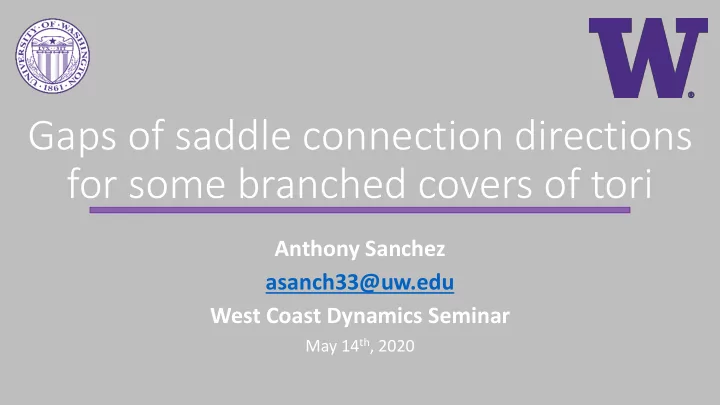

Higher genus These surfaces are called symmetric torus covers . Symmetric torus covers have the same gap distribution as doubled slit tori.
Other results on gaps of translation surfaces • Lattice surfaces (highly symmetric • Non-lattice surfaces translation surfaces)
Gaps of lattice surfaces • Athreya-Cheung (2014) - Torus • Athreya-Chaika-Lelievre (2015) - Golden L • Uyanik-Work (2016) - Regular octagon • Taha (2020)- Gluing two regular (2n+1)-gons
Gaps of lattice surfaces • Athreya-Cheung (2014) - Torus Characteristics of the gap distributions: • • Athreya-Chaika-Lelievre (2015) - No small gaps • Golden L 2-dimensional parameter space • Explicit gap distributions • Uyanik-Work (2016) - Regular octagon • Taha (2020)- Gluing two regular (2n+1)-gons
Gaps of non-lattice surfaces Athreya-Chaika (2012) – Generic translation surfaces • Gap distribution exists for a.e. translation surface and is the same • Non-explicit • Small gaps characterize non-lattice surfaces
Gaps of non-lattice surfaces Athreya-Chaika (2012) – Generic translation surfaces • Gap distribution exists for a.e. translation surface and is the same • Non-explicit • Small gaps characterize non-lattice surfaces Work (2019) – ℋ 2 Genus 2, single cone point • Parameter space 6-dimensional • Non-explicit
Gaps of non-lattice surfaces Athreya-Chaika (2012) – Generic translation surfaces • Gap distribution exists for a.e. translation surface and is the same • Non-explicit • Small gaps characterize non-lattice surfaces Work (2019) – ℋ 2 Genus 2, single cone point • Parameter space 6-dimensional • Non-explicit S. (2020) – Doubled slit tori • Parameter space 4-dimensional • First explicit gap distribution for non-lattice surface
This concludes Part 1
Part 2: Elements of proof Anthony Sanchez asanch33@uw.edu May 14 th , 2020
Elements of the proof • Turn gap question into a dynamical question • On return times and affine lattices
Guiding philosophy Questions about a fixed translation surface can be understood by considering the dynamics on the space of all translation surfaces.
Guiding philosophy Questions about a fixed translation surface can be understood by considering the dynamics on the space of all translation surfaces. Dynamical Gap distribution question on the of a doubled slit space of doubled torus slit tori
Translation surfaces ℰ Let ℰ denote the set of all doubled slit tori
The 𝑇𝑀 2, ℝ -action There is a “linear” action of 𝑇𝑀 2, ℝ on ℰ
The 𝑇𝑀 2, ℝ -action There is a “linear” action of 𝑇𝑀 2, ℝ on ℰ: act on the polygon presentation
The 𝑇𝑀 2, ℝ -action There is a “linear” action of 𝑇𝑀 2, ℝ on ℰ: act on the polygon presentation
The 𝑇𝑀 2, ℝ -action There is a “linear” action of 𝑇𝑀 2, ℝ on ℰ: act on the polygon presentation 1 1 0 1
The 𝑇𝑀 2, ℝ -action There is a “linear” action of 𝑇𝑀 2, ℝ on ℰ: act on the polygon presentation 1 1 0 1
Horocycle flow Consider the 1-parameter family 1 0 ℎ 𝑣 = 1 : 𝑣 ∈ ℝ −𝑣
Horocycle flow Consider the 1-parameter family 1 0 ℎ 𝑣 = 1 : 𝑣 ∈ ℝ −𝑣 • Vertical shear on the plane.
Horocycle flow Consider the 1-parameter family 1 0 ℎ 𝑣 = 1 : 𝑣 ∈ ℝ −𝑣 • Vertical shear on the plane. • This subgroup is of interest because of how it changes slopes.
Slopes 𝑦 𝑦 ℎ 𝑣 𝑧 = 𝑧 − 𝑣𝑦
Slopes 𝑦 𝑦 ℎ 𝑣 𝑧 = 𝑧 − 𝑣𝑦 𝑦 𝑡𝑚𝑝𝑞𝑓 ℎ 𝑣 𝑧
Slopes 𝑦 𝑦 ℎ 𝑣 𝑧 = 𝑧 − 𝑣𝑦 𝑦 𝑦 𝑡𝑚𝑝𝑞𝑓 ℎ 𝑣 = 𝑡𝑚𝑝𝑞𝑓 − 𝑣 𝑧 𝑧
Slopes 𝑦 𝑦 ℎ 𝑣 𝑧 = 𝑧 − 𝑣𝑦 𝑦 𝑦 𝑡𝑚𝑝𝑞𝑓 ℎ 𝑣 = 𝑡𝑚𝑝𝑞𝑓 − 𝑣 𝑧 𝑧 In particular, slope differences are preserved!
Transversal for doubled slit tori Consider the transversal for doubled slit tori 𝒳 = 𝜕𝜗ℰ|𝛭 𝜕 ∩ 0,1 ≠ ∅
Transversal for doubled slit tori Consider the transversal for doubled slit tori 𝒳 = 𝜕𝜗ℰ|𝛭 𝜕 ∩ 0,1 ≠ ∅ That is, the doubled slit tori that have a short horizontal saddle connection.
Recommend
More recommend